Application Assurance — Application Identification and User-Defined Applications
This chapter describes Application Assurance (AA) Application Identification and User-Defined Applications configurations.
Topics in this chapter include:
Applicability
The information and configuration in this chapter were initially based on SR OS Release 11.0.R3, but updates were made based on SR OS Release 19.10.R2.
There are no specific prerequisites for this example.
Overview
This chapter is intended for Application Assurance (AA) network architects and engineers. It provides best practice information to customize the AA policy and classify any type traffic to meet the service provider reporting, charging or control requirements.
In addition to the signatures built and supported by Nokia, service providers can create their own application signatures based on various criteria. This customization capability can be used to classify traffic hosted on the provider network (web portal, streaming service) or hosted on the Internet and not yet covered by the default AA signature set.
Basics and terminology
The following main components are used for AA classification:
Application Filters — App-filters are used to define applications based on Layer 3 to Layer 7 criteria. They provide a mapping between one or more protocol signatures or customized traffic patterns into an application of interest.
Application — Such as BitTorrent®, Netflix®. Traffic is classified into applications using app-filters.
Application Group — Such as peer-to-peer, multimedia streaming. For the purpose of reporting and control, applications of similar type/function can be grouped together in Application Groups (App-Group).
Charging Group — Such as zero rating, default. For the purpose of charging or control, applications and app-group can be grouped together in charging groups.
The following table is a high-level example to illustrate how app-filters are used to defined applications and show their logical grouping into app-group and charging group.
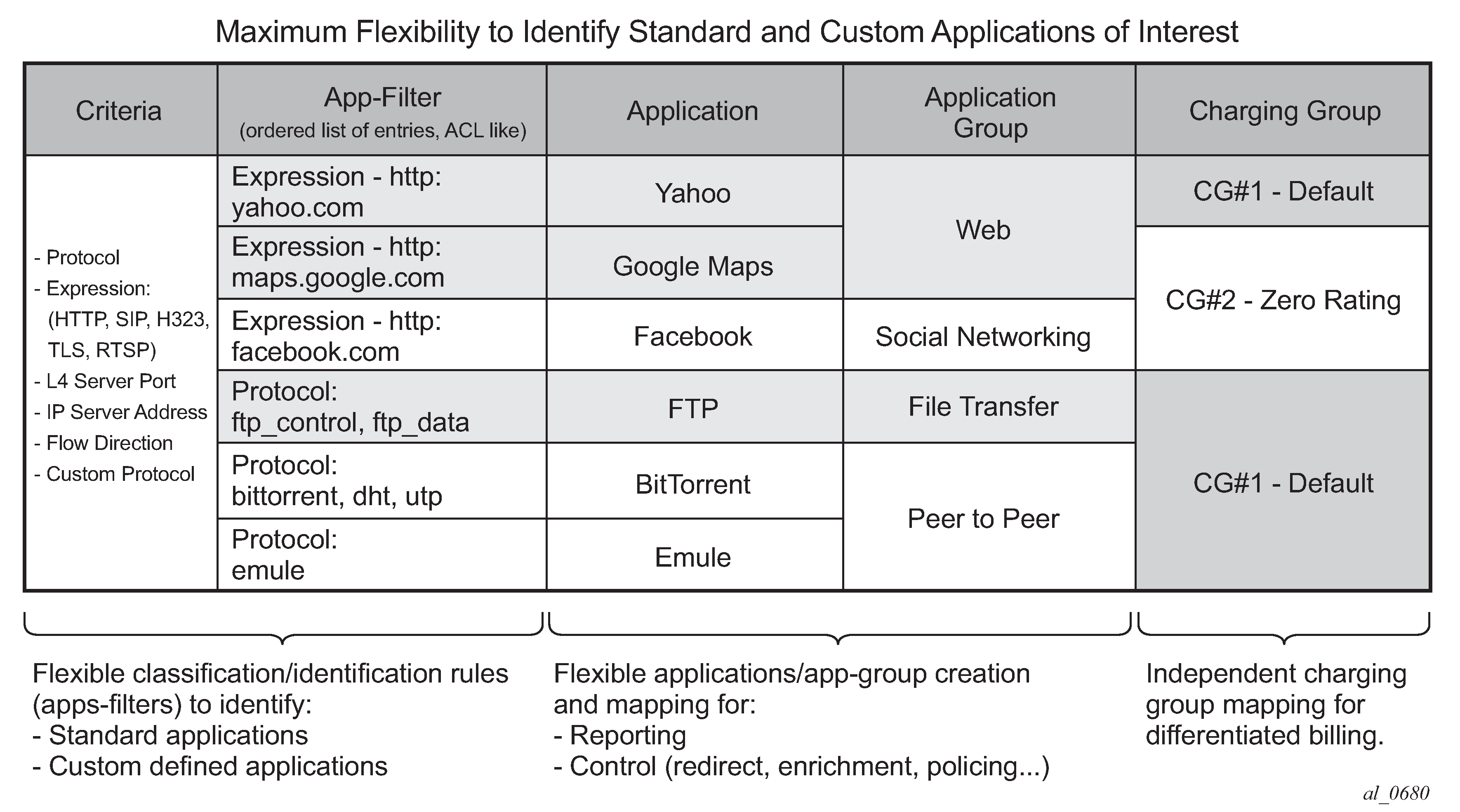
BitTorrent® and Emule® applications are defined using their protocol signature and grouped in the P2P app-group.
FTP application is defined using both ftp_data and ftp_control protocol signatures, the app is mapped in the file transfer app-group.
Google Maps® and Yahoo® web sites are defined using http expression and grouped together in the Web app-group.
Configuration
Classification criteria (App-filter)
The operator can take full advantage of the flexible AA policy configuration to classify traffic from any application of interest using various criteria ranging from Layer 3 to Layer 7 expressions.
Expression match criteria allows to further refine traffic classification by identifying traffic from HTTP, HTTPS (SSL/TLS), SIP, H323, RTSP, Citrix protocol signatures.
The different app-filter match criteria are listed below:
L7 expression
HTTP: host, URI, user agent, referer
SSL/TLS: certificate org name, common name, SNI
H323: product ID
SIP: URI, user agent, media type
RTSP: host, URI, user agent
Citrix: application published name
RTMP: page-host, page-uri, swf-host, swf-uri
IP protocol number
IP server address
TCP/UDP server port
Custom protocol
Protocol signature
The following operators are supported to define expression-based app-filters:
^ : |
Expression starts with |
$ : |
Expression ends with |
*: |
Wildcard - anything before or after |
\I: |
Forces case sensitivity |
\d: |
Any single decimal digit [0-9] |
\.: |
Any single character |
|
\*: |
Asterisk character |
Examples of expression match combinations:
^abcd*: |
match ‛abcd’ at beginning, can end with anything |
*abcd*: |
match ‛abcd’ anywhere |
*abcd$: |
match ‛abcd’ at the end |
^abcd$: |
exact expression match ‛abcd’ |
^ab*cd$: |
string starts with 'ab', ends with 'cd' (anything else in between) |
^ab\dcd$: |
string starts with 'ab', followed by a decimal digit, ends with 'cd' |
It is possible to combine different criteria or expressions within the same filter in which case an implicit AND operation between the criteria within the same filter is done by the system.
Application definition example
The following example provides a basic configuration example with the application FTP made of two protocol signatures ftp_control and ftp_data; the application is mapped into the application group file transfer:
Create the application group.
configure application-assurance group 1:1 policy
app-group "File Transfer"
exit
Create the application.
configure application-assurance group 1:1 policy
application "FTP"
app-group "File Transfer"
exit
Create the app-filters.
configure application-assurance group 1:1 policy
app-filter
entry <1..65535> create
protocol eq "ftp_data"
application "FTP"
no shutdown
exit
entry <1..65535> create
protocol eq "ftp_control"
application "FTP"
no shutdown
exit
Once the application is created, the operator is expected to configure the collection of statistics at the subscriber level for this new application (usually only for business VPNs).
User-defined applications
General recommendations
In order to classify traffic properly, it is recommended to follow the guidelines and best practices defined in this section before creating a new application:
Analyze the application traffic
Identify what type traffic is used (Wireshark®).
Use the application the same way the end user would use it, the same application can create various flows.
Configure the appropriate App-Filters
Following the analysis of the application done above, create the application.
Follow the App-filter best practices chapter to understand in which range to add the filters.
More than one App-filter can be required to identify a single application.
AppDB/default AA policy
The default AA policy called AppDB (Application Database) is provided by Nokia and should be used on most deployments. Contact your regional support organization for more details on how to obtain it.
This configuration includes applications and application-groups most providers can use by default and is designed to allow the addition of any custom entries required by service providers to identify additional services/applications.
The following customization options exist:
Generating a configuration for a particular region (such as APAC)
Generating a new configuration (or updating a configuration) containing specific applications
Before adding new entries to the template and customizing the configuration, it is recommended to follow the next guidelines on app-filters and ranges. These guidelines are key to allow an easy upgrade path from the policy configuration provided by Nokia.
App-filters
App-filters are an ordered list of entries. It is important to keep the order of this list consistent with the classification objective.
For instance, a common configuration mistake is to configure a filter rule for the HTTP protocol signature before HTTP expression filters. If that were the case, then app-filters using HTTP expressions would not be used as the system would find an acceptable match with the protocol signature before walking the list of expressions configured. This mistake is described in the following example:
|
This is an incorrect App-filter order. App-filter entry #100 will always match before the http expression entry #110. |
It is not necessary to specify a protocol when defining an expression filter, the protocol is implicit based on the type of expression match criteria used (for instance, HTTP, SIP, H323).
App-filter ranges
The App-filter list is an ordered list, it is key to configure each app-filter in the right order and in the proper range.
The operator can customize the policy and create applications and app-filters by using the following ranges shown in Customer reserved App-filter ranges (other ranges are used by the default policy):
Range Name |
Description |
Start |
End |
|---|---|---|---|
Extended top range |
Top range, matches before any other filters |
1 |
1499 |
High priority |
Top range for high priority matches |
2000 |
4999 |
Expression range A |
HTTP Host, Host+URI; optionally with IP/Port match |
19000 |
22999 |
Expression range B |
Other Expression Match; optionally with IP/Port match |
33000 |
34999 |
Extended protocols |
Protocol-signature + Port|IP|Dir. match |
40000 |
58999 |
Custom protocols |
Custom protocol signature match |
61000 |
61999 |
Trusted/validate ports |
1st packet validate, 1st packet trusted match |
62000 |
63999 |
Ordering basics:
Layer 7 expression-based filters are located before their parent protocol signature (for example, expression matches on http are located before the HTTP protocol app-filter; the same applies to TLS, SIP, H323, RTSP, Citrix).
HTTP host and URI are located before the HTTP referer for accounting accuracy (for example, YouTube® from within Facebook® is classified as YouTube®)
App-filters combining protocol signatures with Layer 4 port, IP protocol, IP address, or flow direction are always located before the protocol signature only filter range.
HTTP
Protocol
HTTP is a client/server protocol using TCP/IP at the transport layer to deliver resources such as HTML files, images, videos and more.
HTTP 1.1 enables HTTP clients to use a persistent connection to a server allowing them to reuse the same TCP session for multiple HTTP transactions. Text, images, video, scripts and other objects can be downloaded individually in different transactions through the same TCP session.
HTTP persistent connection describes a typical persistent HTTP connection between a web client and a server with multiple HTTP transactions within the same TCP session:

User-defined expression-based HTTP applications will use the first HTTP transaction to classify the flow (optionally this behavior can be modified).
HTTP request
The following example shows the content of a typical HTTP request to wikipedia.org which includes the following header fields: HTTP Host, HTTP URI, HTTP User Agent and HTTP referer fields:
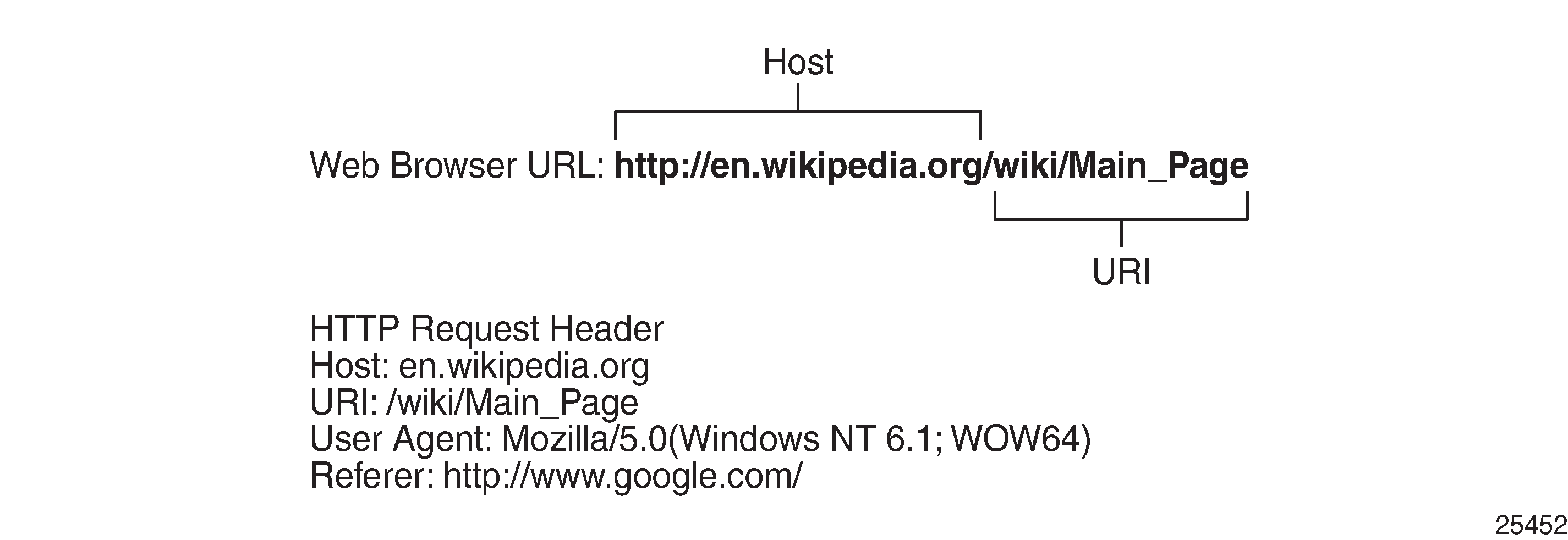
HTTP Host — Represents the domain name (does not include ‟http://”).
HTTP URI — The URL trailer after the host domain name (begins with slash ‟/”).
HTTP Referer — The address of the previous web page from which a link to the currently requested page was followed (in this example, the referer is www.google.com which means the user clicked on a link from a Google search pointing to wikipedia.org).
HTTP User Agent — This identifies the web browser or application making the HTTP request.
Configuration examples
HTTP host (Wikipedia)
Classifying HTTP traffic from this web site can be done using a single expression tail anchored on the HTTP host:
configure application-assurance group 1:1 policy app-filter
entry <1..65535> create
description "Wikipedia Web Access" expression 1 http-host eq "*.wikipedia.org$"
application "Wikipedia"
no shutdown
exit
This can be confirmed using Wireshark®.
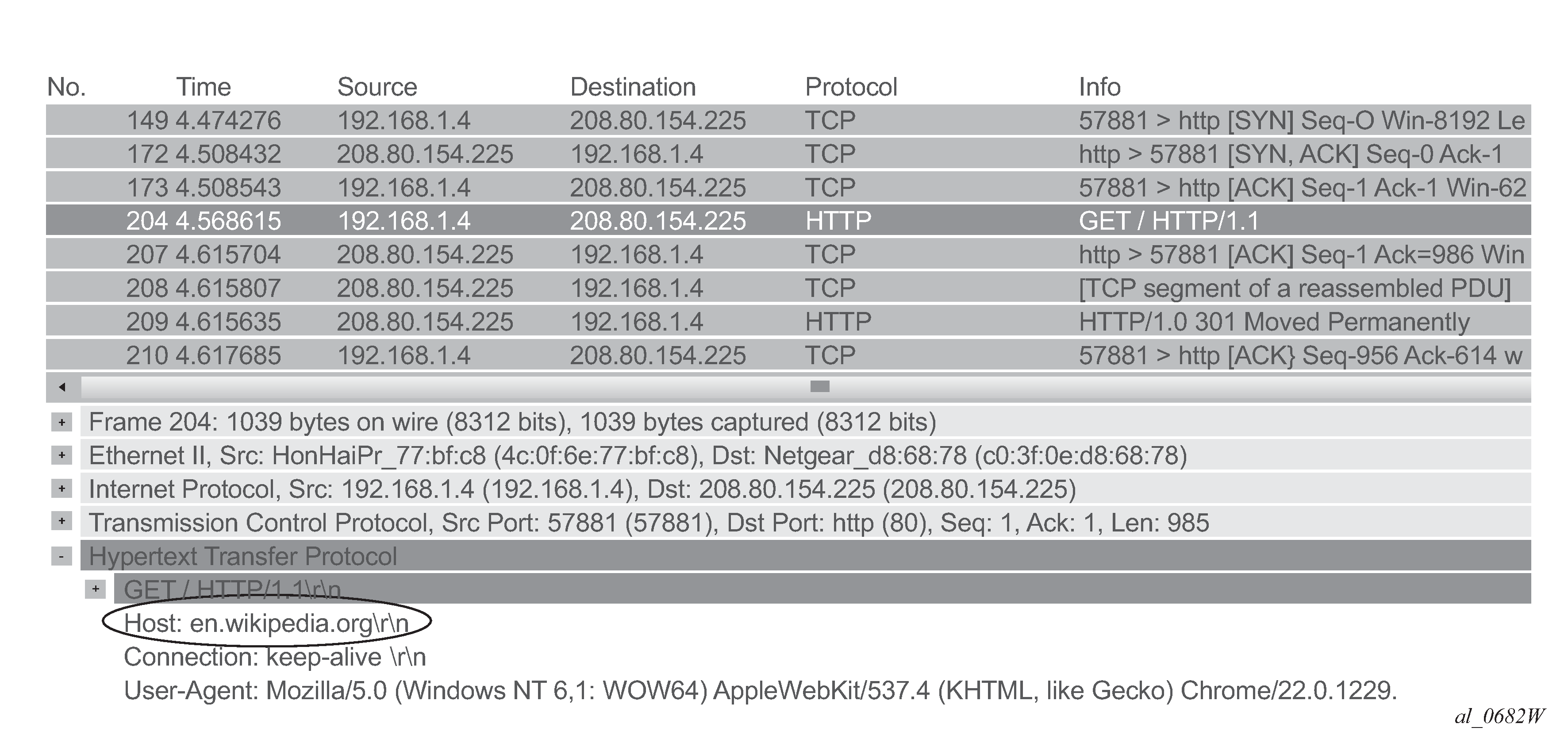
Classification per URI within the same host
Operators may need to apply different charging rules to different content located on the same HTTP domain (different URI, same HOST).
Classification rules for the ISP ON-NET content services displays an example of classification rules for the ISP ON-NET content services:
URL |
Charging rule |
AA application |
|---|---|---|
www.ispdomain.com/video |
Rule #1 – 0 Rating |
ISP-Portal-Video |
www.ispdomain.com/images |
Rule #2 – Charge X |
ISP-Portal-Images |
www.ispdomain.com/* |
Rule #3 – Charge Y |
ISP-Portal-Default |
HTTP 1.1 can reuse the same TCP connection for many transactions to the same server. Classifying each HTTP transaction to www.ispdomain.com independently requires a specific AA configuration.
SR OS allows to selectively enable ‟http-match-all-requests” in app-filters to improve the system performance and limit the HTTP analysis per domain.
The following configuration example allows traffic classification of different URIs of the same domain (www.ispdomain.com) independently, therefore allowing differentiated charging and control:
http-match-all-req is enabled on all host+uri app-filters to www.ispdomain.com
default app-filter required to match any traffic to www.ispdomain.com
configure application-assurance group 1:1 policy app-filter entry <1..65535> create description "Zero rated content" expression 1 http-host eq "^www.ispdomain.com$" expression 2 http-uri eq "^/video*" http-match-all-req application "ISP Portal Video" no shutdown exit entry <1..65535> create description "Image charging" expression 1 http-host eq "^www.ispdomain.com$" expression 2 http-uri eq "^/images*" http-match-all-req application "ISP Portal Images" no shutdown exit entry <1..65535> create description "Default charging" expression 1 http-host eq "^www.ispdomain.com$" http-match-all-req application "ISP Portal Default" no shutdown exit
SSL/TLS (HTTPs)
Protocol
HTTPS uses SSL/TLS to encrypt traffic between the client and the server. Because this communication is encrypted, it is not possible to identify the HTTP Host or URI. However, AA can still identify the service requested by the subscriber by looking at the TLS certificate information or Server Name Indication exchanged in the clear before the TLS session is established.
SSL/TLS expression-based app-filters are not limited to HTTPS. HTTPS is not a protocol in itself, but it is HTTP traffic, tunneled encrypted into SSL/TLS on port 443.
SSL/TLS certificates
The following snapshot (Wireshark® HTTPS www.whatsapp.com) from Wireshark shows the SSL/TLS certificate exchanged using the mobile application whatsapp®.
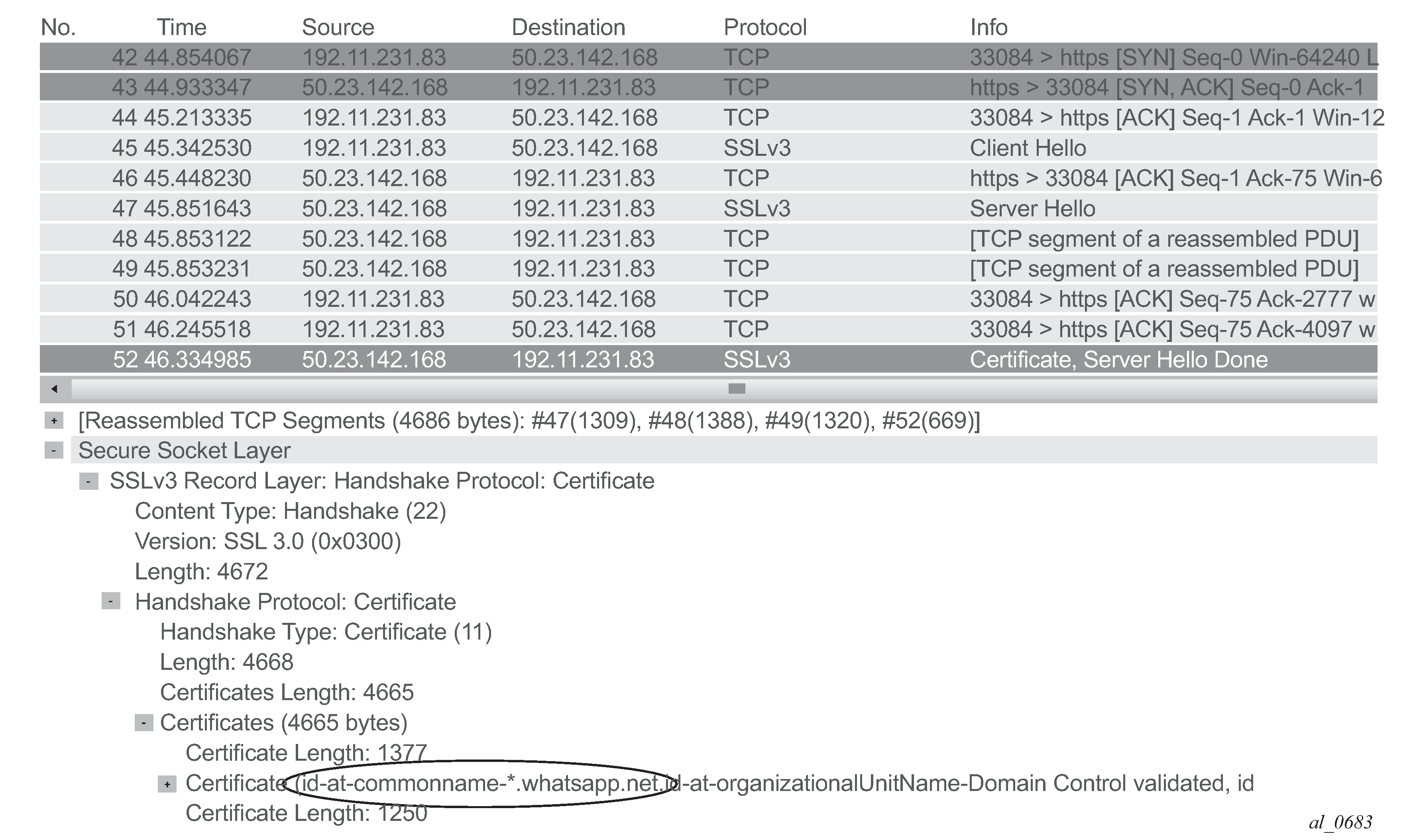
The certificate information can be found in the Server Hello message sent by the server, capturing SSL/TLS (HTTPS) traffic from this application can be done using a single app-filter entry tail anchored on the TLS Common Name Certificate:
configure application-assurance group 1:1 policy
app-filter
entry <1..65535> create
description "Whats App tls and image/voice/video traffic"
expression 1 tls-cert-subj-common-name eq
"*.whatsapp.net$"
application "Whats App"
no shutdown
exit
Server name indication
SSL/TLS traffic can optionally be identified using the Server Name Indication (SNI) which is an extension to the TLS protocol.
The SNI is found in the TLS Client Hello, the http-host expression in the app-filter is reused to classify this traffic:
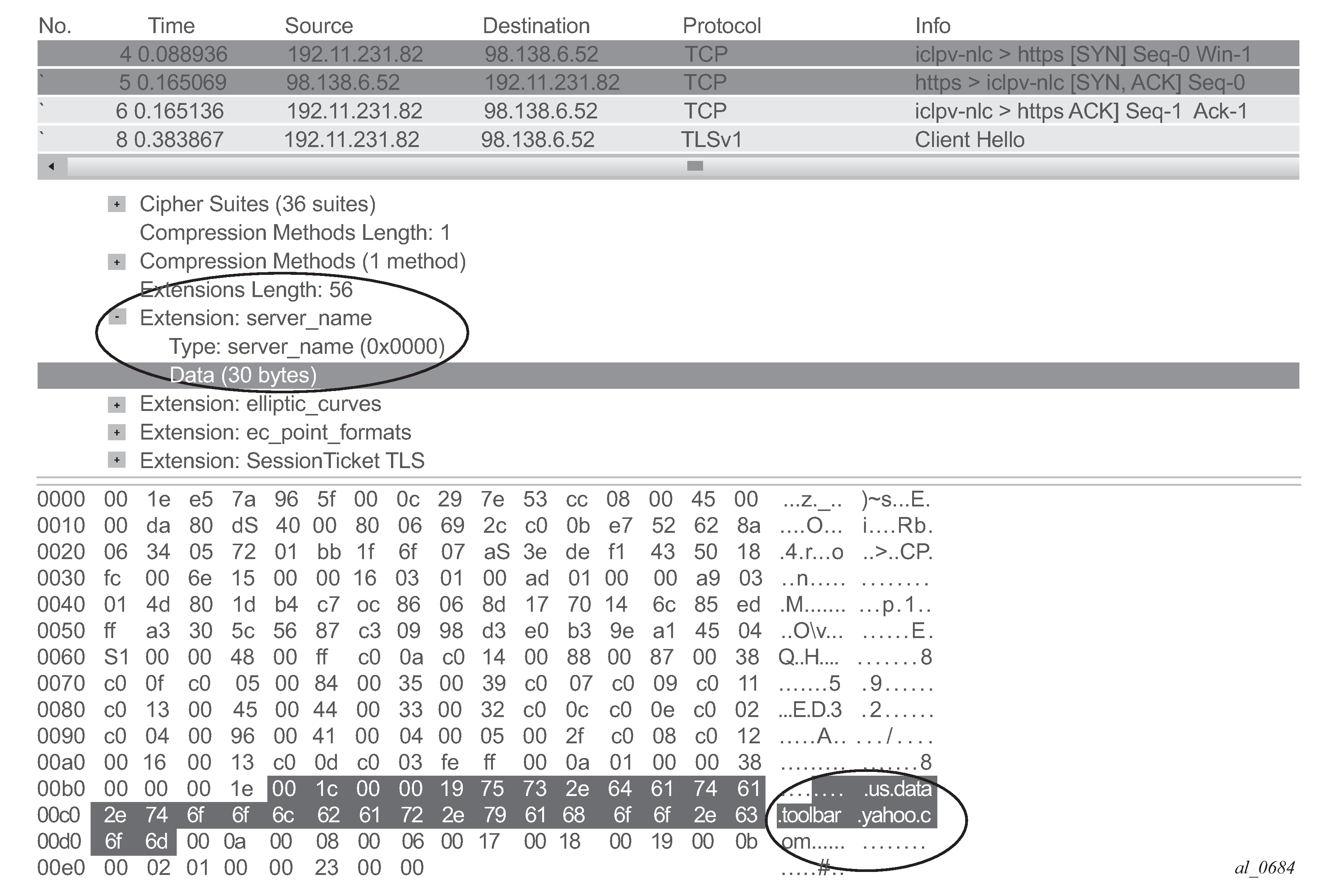
configure application-assurance group 1:1 policy
app-filter
entry <1..65535> create
description "Yahoo HTTP or TLS SNI"
expression 1 http-host eq "*.yahoo.com$"
application "Yahoo"
no shutdown
exit
SIP
Protocol
SIP is a signaling protocol used for controlling multimedia communication sessions such as voice and video over RTP. AA automatically monitors SIP control flows and associates RTP/RTCP media flows accordingly in the sip_rtp protocol signature.
The operator can use a SIP expression match criteria in app-filter to further refine traffic classification and identify any additional application on top of the default AA policy. This can be particularly useful in business VPNs to identify voice and telepresence applications.
AA supports SIP expression match criteria on SIP URI, SIP user agent and SIP media type. The following snapshot from Wireshark® shows a SIP control exchange using the voice-video application Vonage® followed by the RTP media audio flow; the expression fields that can be matched using AA app-filters are highlighted:
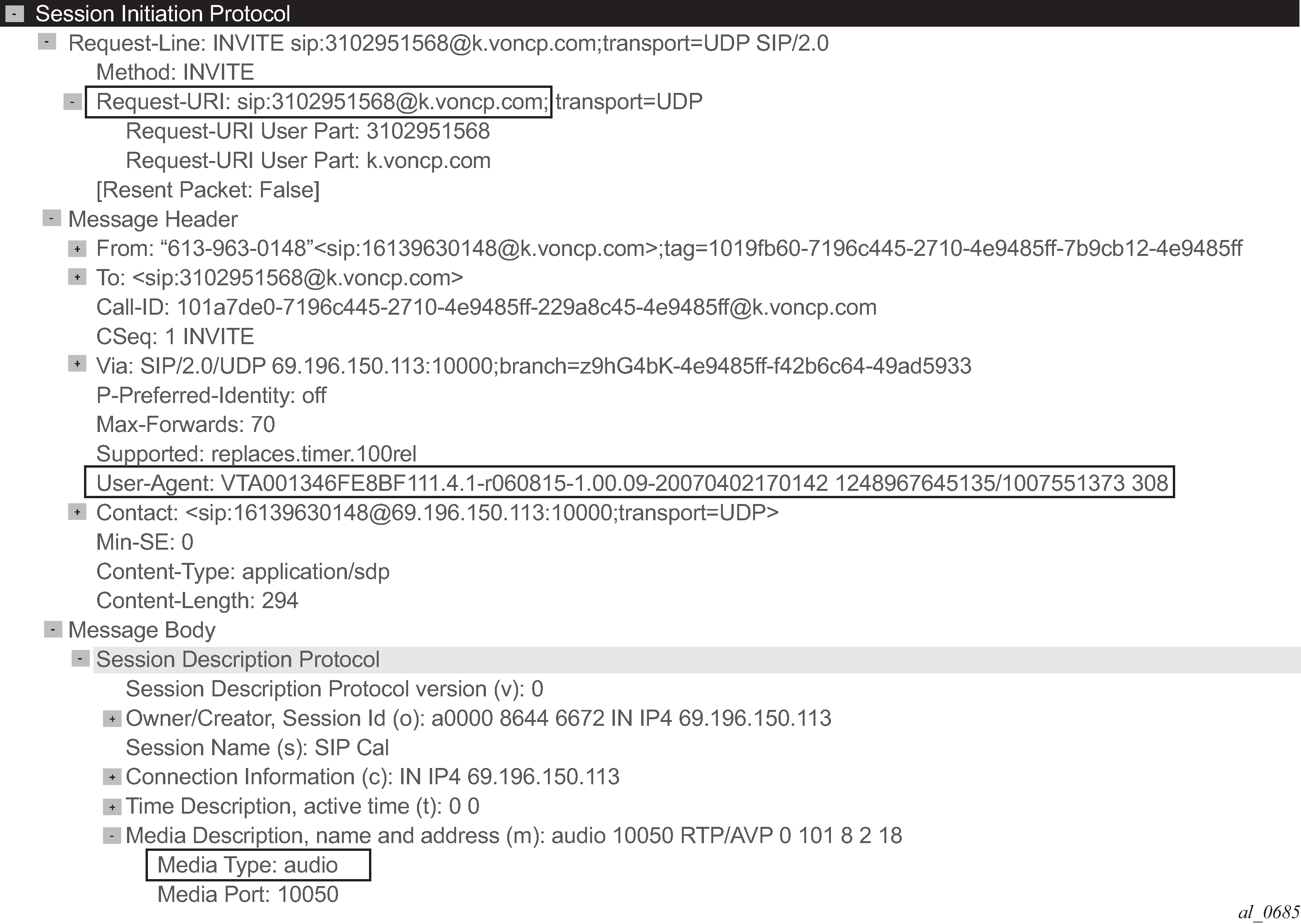
Configuration example
The following configuration example provides the configuration to classify Vonage® SIP/RTP desktop traffic using SIP URI expression:
configure application-assurance group 1:1 policy
app-filter
entry <1..65535> create
description "Vonage"
expression 1 sip-uri eq "*voncp.com*"
application "Vonage"
no shutdown
exit
H323
Protocol
Similar to SIP, H323 is a signaling protocol used for controlling multimedia communication sessions such as voice and video over RTP. AA automatically monitors H323 control flows and associates the RTP media flow accordingly in the h323_rtp protocol signature.
The operator can use an H323 expression match criteria app-filter to further refine traffic classification and identify any additional application on top of the default AA policy. This can be particularly useful in business VPNs to identify voice and telepresence applications.
AA supports H323 expression match criteria on the H323 product ID. The following snapshot from Wireshark shows an H323 control exchange using the Telepresence application LifeSize® followed by the RTP media audio flow; the expression field that can be matched using AA app-filters is highlighted:
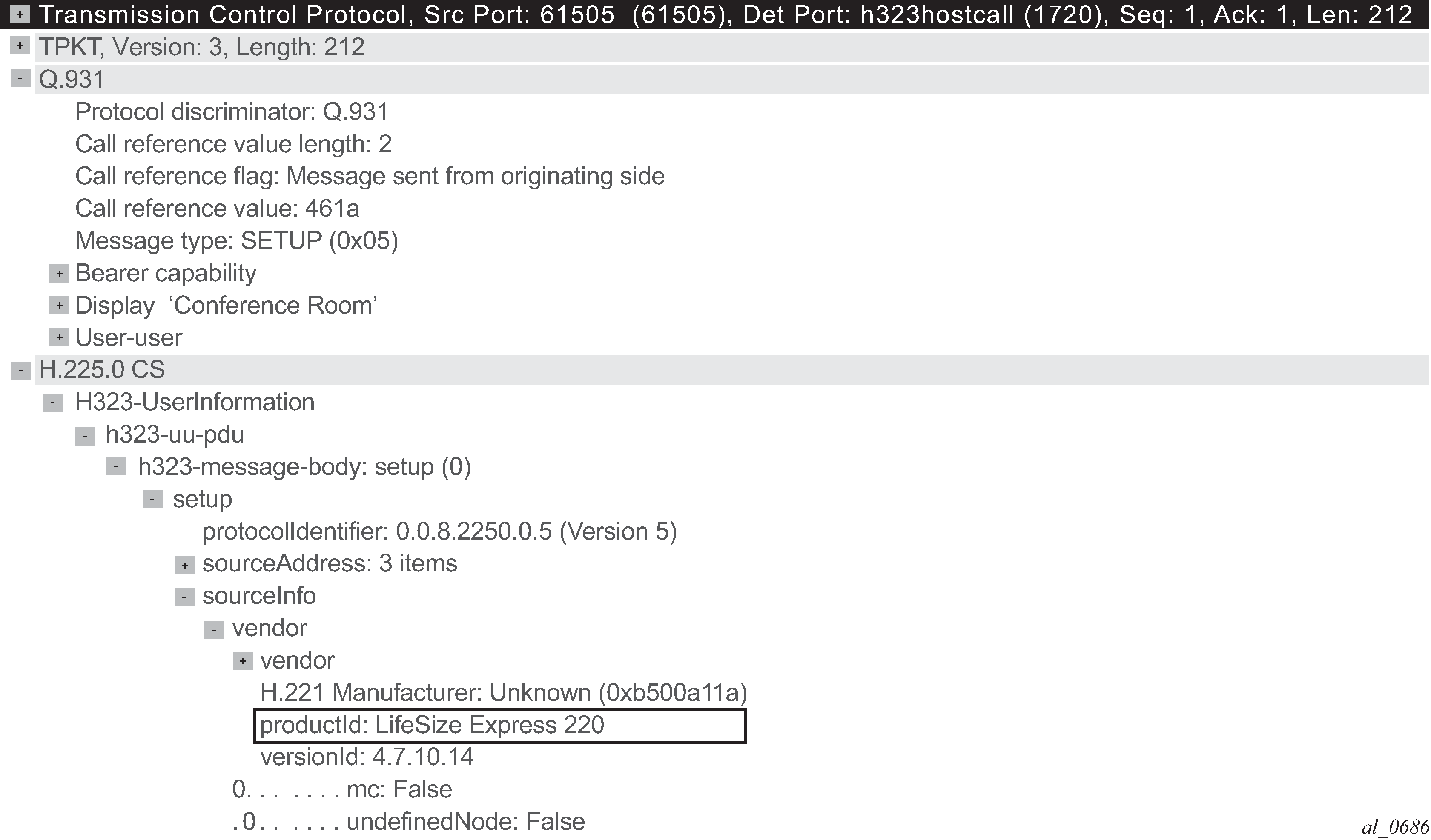
Configuration example
The following configuration example provides the configuration to classify LifeSize® H323/RTP traffic using the H323 product ID expression:
configure application-assurance group 1:1 policy
app-filter
entry <1..65535> create
description "LifeSize H323 traffic"
expression 1 h323-product-id eq "^LifeSize*"
application "LifeSize"
no shutdown
exit
RTSP
Protocol
RTSP is a signaling protocol used for controlling media streaming content such as audio and video over RTP/RDT. AA automatically monitors the RTSP control flows and associates its RTP/RDT media flow with the rtp_rtsp protocol signature.
The operator can use an RTSP expression match criteria app-filter to further refine traffic classification and identify any additional application on top of the default AA policy. This can be particularly useful to identify specific streaming applications.
AA supports RTSP expression match criteria on the RTSP Host, URI, User Agent. The following snapshot from Wireshark® shows an RTSP setup request to YouTube® followed by the RTP media audio flow; the expression fields that can be matched in RTSP SETUP request using AA app- filters are highlighted:
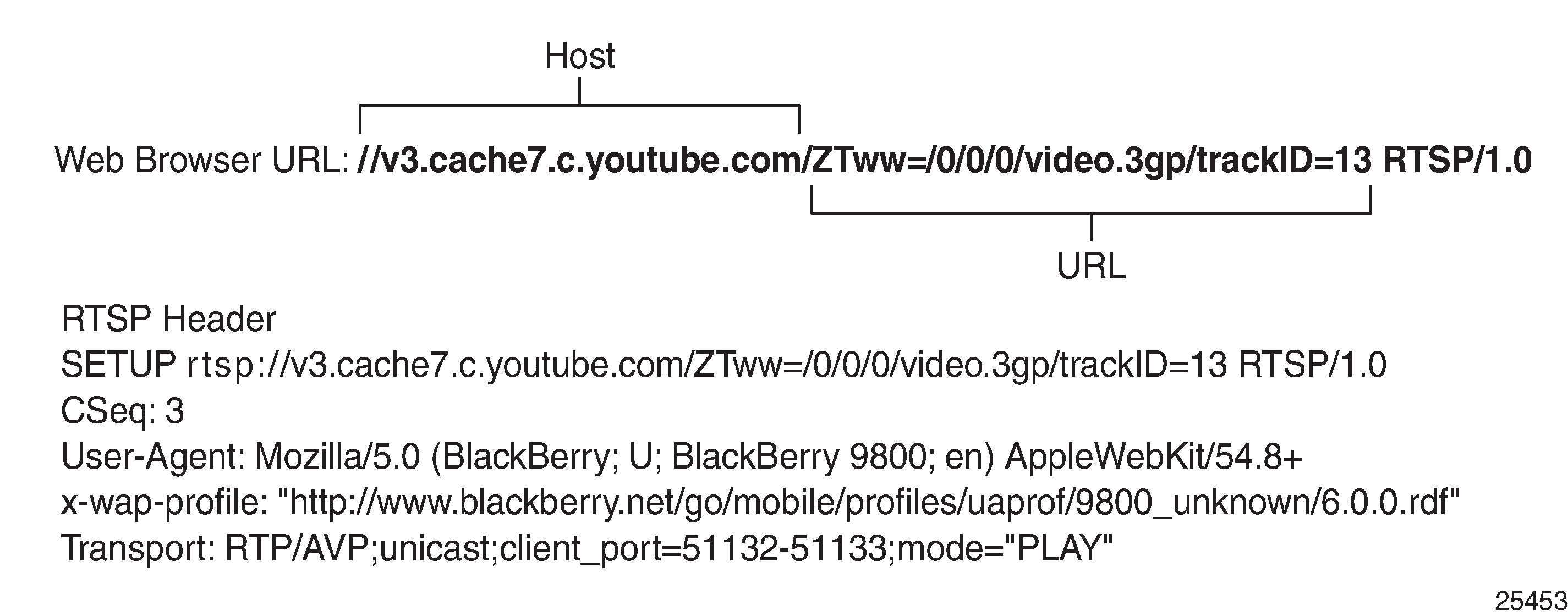
Configuration example
The following configuration example provides the configuration to classify YouTube® RTSP/RTP traffic using RTSP Host expression:
configure application-assurance group 1:1 policy
app-filter
entry <1..65535> create
description "YouTube RTSP/RTP Video"
expression 1 rtsp-host eq "*.youtube.com$"
application "YouTube"
no shutdown
exit
Citrix
Protocol
Independent Computing Architecture (ICA) is a Citrix Systems® protocol used in Citrix’s WinFrame, Citrix XenApp (formerly called MetaFrame/Presentation Server), and Citrix XenDesktop products.
Citrix makes it possible to run applications remotely on large servers, thus making better use of server resources while at the same time allowing people using other platforms to use the applications, for example, run Microsoft® Word on a UNIX workstation.
Citrix_ica protocol signature will detect any remote application using Citrix (the protocol needs to be unencrypted and configured to non-seamless). The Citrix ICA session is started from a client and can be anything from Remote Desktop, SAP to Microsoft® Word.
The Citrix expression match app-filter is used to classify traffic based on the Citrix-published application. This published application is configured on the server and in the preceding example, it can be for instance RDP, SAP, Word, XLS or Microsoft® Word depending how the server is configured.
Configuration example
configure application-assurance group 1:1 policy
app-filter
entry <1..65535> create
description "Citrix SAP Application"
expression 1 citrix-app eq "SAP"
application "Citrix SAP"
no shutdown
exit
IP address and TCP/UDP port
Traffic from specific servers can be classified using IPv4/v6 server-address app-filter rules. It is used usually to identify traffic from an internal (on-net) server as opposed to an Internet (off-net) server.
The server-address app-filter automatically detects the client from the server by identifying which side opens the connection. It implicitly classifies traffic based on the server IP address or port number. For example, if A initiates a TCP connection to B, then flows from A to B and from B to A can be classified with a match on server-address B. Similarly, a flow initiated from B to A can be classified using a match on server-address A.
Server address
The following configuration example uses a server-address app-filter to classify traffic from server 10.1.1.1 in the application called Application-1:
configure application-assurance group 1:1 policy
app-filter
entry <1..65535> create
description "Server #1 10.0.0.1"
server-address eq 10.0.0.1/32
application "Application-1"
no shutdown
exit
Server address and server port
The following configuration example uses server-address and server-port app-filters to classify traffic from server 10.0.0.2 on port 1234 in the application called Application-2. It is particularly useful when the same server is used to provide different services that need to be classified separately:
configure application-assurance group 1:1 policy
entry <1..65535> create
description "Server #2 10.0.0.2 port 1234 Only"
server-address eq 10.0.0.2/32
server-port eq 1234
application "Application-2"
no shutdown
exit
Server port and protocol signature
It is possible to combine a protocol signature with a port number in the same app-filter, this is typically done in business VPNs for specific internal applications not detected using existing AA protocol signatures.
The following configuration example classifies a business VPN application running on TCP port 4000 and not detected by any other signatures. It combines the protocol signature unknown_tcp with the desired port number. This allows keeping the classification untouched for the rest of the protocols/applications and is the recommended approach:
configure application-assurance group 1:1 policy
app-filter
entry <1..65535> create
description "Business VPN Application X Port 4000"
server-port eq 4000
protocol eq unknown_tcp
application "Busines VPN Application X"
no shutdown
exit
It is important to follow the app-filter range recommendations for a proper classification of traffic using IP address or port number.
Flow setup direction
Traffic can be classified based on flow-setup-direction app-filter. The flow setup direction can be either subscriber-to-network or network-to-subscriber.
Network side and subscriber side is AA terminology related to where AA is enabled:
In broadband and mobile networks, AA is enabled per subscriber. This means the subscriber side represents the ESM/mobile/transit subscriber while the network side represents Internet or other subscribers.
In business VPNs, AA is enabled on a VPN SAP/spoke SDP and the subscriber side represents the local VPN site (SAP/spoke/transit).
The following example shows the configuration to classify http traffic hosted by AA subscribers (for example, broadband subscribers running a web server):
configure application-assurance group 1:1 policy
app-filter
entry <1..65535> create
description "HTTP Server on the subscriber side"
flow-setup-direction network-to-subscriber
protocol eq http
application "HTTP Server"
no shutdown
exit
IP protocol
Traffic can be classified using an IP protocol number for non TCP/UDP traffic.
The following example provides the configuration to classify ICMP IPv4/v6 traffic:
configure application-assurance group 1:1 policy
app-filter
entry <1..65535> create
description "ICMP v4"
protocol eq "non_tcp_udp"
ip-protocol-num eq icmp
application "ICMP"
no shutdown
exit
entry <1..65535> create
description " ICMP v6"
protocol eq "non_tcp_udp"
ip-protocol-num eq ipv6-icmp
application "ICMP"
no shutdown
exit
Custom protocol
Custom protocols can be used to classify TCP/UDP applications using hexadecimal string matching (up to 16 hex octets) at a configurable payload offset in the data payload. The expression string length and offset must not exceed 128 bytes.
To illustrate this feature the Solaris® application GoGlobal is used. It provides remote access to a server (similar to VNC®). The following snapshot (SIP Wireshark® capture) from Wireshark® shows a TCP SYN/ACK session establishment followed by the first data exchange:
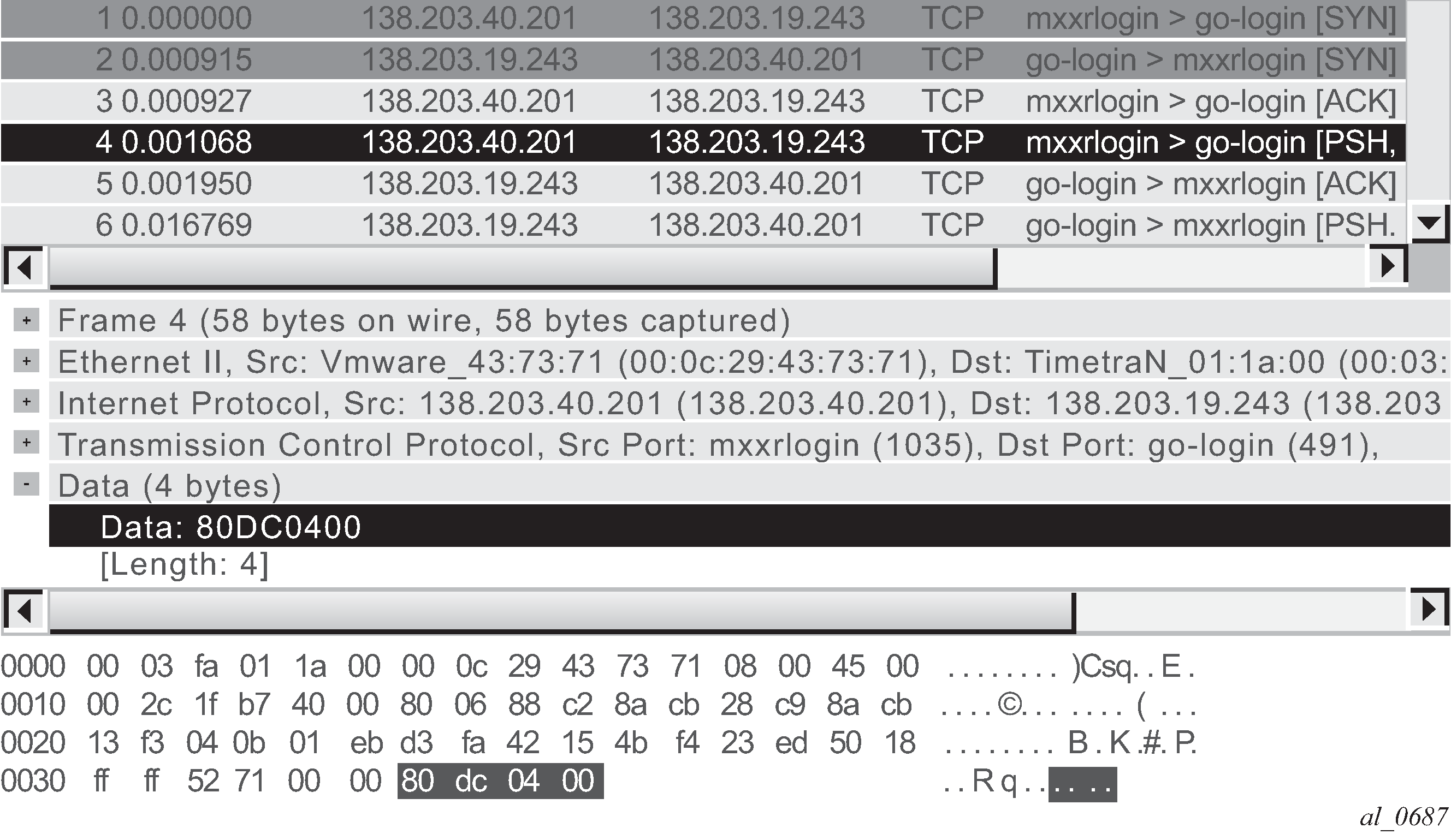
Wireshark® shows that each TCP session payload starts with 80DC0400 (no offset) after the three-way TCP handshake. As a result, the configuration required to classify this traffic is as follows:
configure application-assurance group 1:1 policy
custom-protocol 1 ip-protocol-num tcp create
description "goglobal tcp"
expression 1 eq "\x80\xdc\x04\x00" offset 0 direction client-to-server
no shutdown
exit
app-filter
entry <1..65535> create
description "GoGlobal "
protocol eq "custom_01"
application "GoGlobal"
no shutdown
exit
Typical configuration mistakes
An operator creating new user-defined applications can make a few typical mistakes which are listed below:
App-filters in shutdown state — The default app-filter state is shutdown. A no shutdown command must be executed in order for it to be enabled.
App-filters with no match criteria — This is a more troublesome mistake as it will catch all the traffic entering the filter in a particular application.
Troubleshooting application identification
Show commands
Router/partition statistics
Partition level statistics are not updated in real time. Instead, statistics for a particular flow are updated either at flow closure or every five minutes. The five-minute sliding window interval is a common interval for all flows in an ISA MDA. Different ISA MDAs will have a different five-minute windows as this interval is set at the MDA boot time.
The following command can be used to view the statistics for all applications configured in the ISA Group 1, Partition 1:
show application-assurance group 1:1 application count
Alternatively, it is possible to sort the display by octets, packets, flows:
show application-assurance group 1:1 application count top [octets | packets | flows] [max-count <max-count>]
The operator can also identify which app-filters are being hit by the AA policy per partition (this command is not available per subscriber), it is particularly useful to identify which filters are used and optionally prune unnecessary app-filters from user-defined applications:
show application-assurance group 1:1 policy app-filter
The app-filter policy is usually relatively large, in which case additional 7x50 SR CLI functionality can be used to filter out the output and only show the relevant information.
The following example was created for the application FTP:
A:PE# show application-assurance group 1:1 policy app-filter | match "application \"FTP\""
pre-lines 3 post-lines 2
exit
entry 44300 create (2 flows, 1205 B)
protocol eq "ftp_control"
application "FTP"
no shutdown
exit
entry 44301 create (2 flows, 1401 B)
protocol eq "ftp_data"
application "FTP"
no shutdown
exit
Because partition level statistics are not updated in real time, it is recommended for troubleshooting purposes to use subscriber statistics or sub-study statistics.
Subscriber statistics
Subscriber-level statistics can be updated in real time. AA is usually configured by the operator to collect subscriber-level statistics for all application groups in residential and Wifi, while business VPNs typically collect Application group and all applications for each site with AA enabled.
The following commands can be used to view per subscriber statistics for all app-groups or applications configured in ISA group 1, partition 1 for the ESM subscriber "Bob" or business VPN SAP 1/1/1:10:
show application-assurance group 1:1 aa-sub esm "bob" app-group count
show application-assurance group 1:1 aa-sub sap 1/1/1:10 application count
In case only app-group statistics are collected per subscriber, the aa-sub-study feature can be used to collect per application-level statistics for selected subscribers, as follows:
A:PE# configure application-assurance group 1:1 statistics aa-sub-study application
A:PE>config>app-assure>group>statistics>aa-sub-study# aa-sub esm "bob"
Once done, the system will show all application level statistics for this subscriber:
show application-assurance group 1:1 aa-sub-study esm "bob" application count
Similar to partition-level statistics, aa-sub and aa-sub-study statistics can be sorted by octets, packets, flows:
show application-assurance group 1:1 aa-sub-study esm "bob" application count top [octets | packets | flows] [max-count <max-count>]
When the number of flows per ISA card reaches a threshold then per subscriber statistics are not available in real time anymore and only the snapshot command can be used to display the statistics recorded in the previous five-minute interval window:
show application-assurance group 1:1 aa-sub-study esm "bob" snapshot application count
AppFilterMiss
The default policy configuration provides a failsafe application at the very end of the app-filter list to classify any remaining traffic in the AppFilterMiss application. There should never be any traffic in this application. This failsafe filter is used as a debug to make sure that there are no major issues in the configuration.
Traffic can typically be classified as AppFilterMiss when not all protocol signatures are mapped to a particular application. This could happen when upgrading to a new ISA software and enabling new protocol signature detection while not ensuring first that the correct application was provisioned. See the Release Note upgrade section for more details on AA signature upgrade.
Tools
Flow-record-search
Traditional show commands may not provide enough information when troubleshooting flow identification and the operator can use the ISA flow-record-search tool to dump the ISA flow table for more information. This feature comes with a large number of filtering options documented in the user guide.
Each flow gives visibility into: Flow ID, Sub-Type, Sub-Name, Initiator, Direction, Source IP, Dest. IP, IP Protocol, Source Port, Dest. Port, FC, DSCP, Classified, Protocol, Application, App- Group, Charging Group, Packets tx, Bytes Tx, Packets-discarded, Bytes-discarded etc.
See below for the most commonly used commands.
The following command shows all the flows in an ISA card per ISA group:partition (can be a very long output, up to 3M entries):
application-assurance group 1:1 flow-record-search isa 1/2
The following command shows all the flows per AA subscriber in a given group:partition:
tools dump application-assurance group 1:1 flow-record-search aa-sub esm "bob"
The following command shows all the active flows per AA subscriber in a given group:partition:
tools dump application-assurance group 1:1 flow-record-search aa-sub esm "bob" flow- status active
The flow-record-search command is also available with additional details by adding search-type detail at the end of the command line. Note that due to the length of the output it is recommended to paste the CLI output content in a notepad file.
HTTP host recorder
AA cflowd allows operators to export the HTTP domain extracted from HTTP flows to the NSP cflowd collector. This allows the operator to understand which HTTP hosts are visible in the network.
However, in case a cflowd collector is not deployed, AA provides the HTTP host recorder tool command to record HTTP hosts seen by AA. See the Multiservice ISA and ESA Guide for more details.
A:PE# show debug
debug
application-assurance
group 1:1
http-host-recorder
filter
default-filter-action record
record http-host-app-filter-candidates
exit
rate 100
no shutdown
exit
exit
exit
exit
A:PE# tools dump application-assurance group 1:1 http-host-recorder top bytes
Port recorder
This function is particularly useful in business VPN (it can also be used in residential networks). The port-recorder AA tool function is similar to the http-recorder. It allows the operator to record which ports are used on selected applications.
It is most commonly used with the applications Unidentified TCP and Unidentified UDP but it can be configured to record any other applications:
A:PE# show debug
debug
application-assurance
group 1:1
port-recorder
application "Unidentified TCP"
application "Unidentified UDP"
rate 100
shutdown
exit
exit
exit
exit
A:PE# tools dump application-assurance group 1:1 port-recorder top bytes
Conclusion
This example, which is intended for Application Assurance network architects and engineers, provides the information required to modify an existing AA policy following AA best practices and guidelines, and provides the necessary troubleshooting information to better understand application classification using Application Assurance.